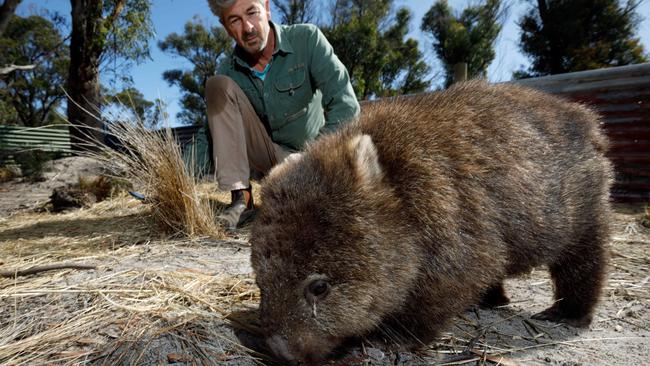Mange plague alarms wombat worriers
Wombats are falling victim to sarcoptic mange, a deadly condition caused by flesh-eating mites that causes a slow death.

Humans are not the only species fighting a rampant plague; wombats are being decimated by an insidious killer, amid claims of government inaction and cover-up.
Wombats across four states and the ACT are falling victim to sarcoptic mange, a deadly condition caused by flesh-eating mites that causes a slow death by starvation or infection.
Small groups of volunteers are treating as many of the stoic marsupials as possible, but say they receive no help from government.
Some say the iconic species has disappeared from entire regions and faces an existential threat while governments dither or play down the scale of the problem.
“It’s happening all across Australia and nobody is doing a bloody thing about it, apart from a handful of (wildlife) carers,” said John Harris, founder of the Tasmanian Wombat Warriors, whose members rescue and treat sick wombats. “I fear we are going to lose this species. I’m concerned there will be an extinction.”
State governments generally dismiss such concerns. Even in Tasmania, where Mr Harris said official records showed 3347 wombats had succumbed to the disease in recent years, the government played down the problem. “Wombat mange has affected Tasmanian wombats for over 100 years and occurs across the state,” a state government spokeswoman said.
“Wombat population monitoring indicates that the overall population size has not been affected by mange, with the overall prevalence of mange in wombats in Tasmania low.
“Importantly, wombats are not a threatened nor an endangered, species. The (relevant) department has been working with community groups, individuals and research organisations to continue to improve understanding of the disease, its presence, impacts and possible treatments.”
However, a recent national report on the issue backed concerns, calling for a “national framework” to tackle the disease, which it said was affecting base-nosed and southern hairy-nosed wombats in NSW, SA, Victoria, WA, Tasmania and the ACT.
“In short, sarcoptic mange appears to fall between the cracks of Australia’s wildlife management system,” the report concluded, warning that without reliable data, “Australia might discover too late that mange is a bigger problem that anyone thought possible”.
Mr Harris said official figures were based on flawed spotlight surveys, while volunteers had found an effective treatment, an insecticide called Bravecto, only for government to impose impossible hurdles to its legal use.
While the Tasmanian government was funding a university study into its use to treat wombats, he believed action was needed immediately to avoid thousands more “barbaric” deaths. He said volunteers had to break the law to use Bravecto, and dip into their own pockets for the $80-per-treatment cost, as well as the cost of feeding wombats while in their care.
The Tasmanian government suggested it was doing more than most to tackle the disease, including funding treatment trials.
“The University of Tasmania has undertaken trials with wombats in captivity to determine the potential effectiveness of this insecticide treatment, and is now planning field trials in both Tasmania and NSW,” the spokeswoman said.
“It is important to note that at this stage there is no authorisation from the Australian Pesticides and Veterinary Medicines Authority for broadscale use of Bravecto in wildlife populations, as conditions … to ensure effectiveness, appropriate dosage and safe usage are not yet known.”



